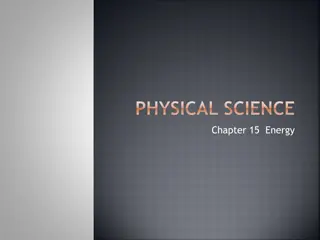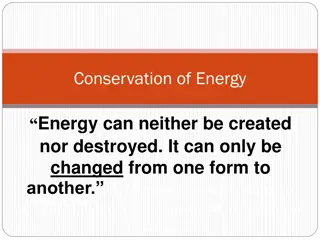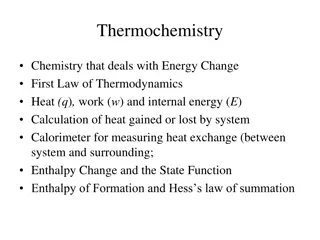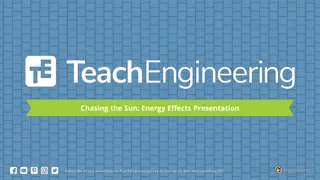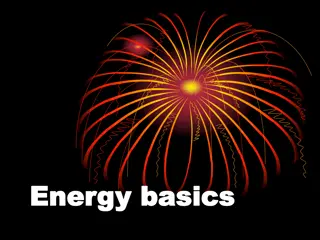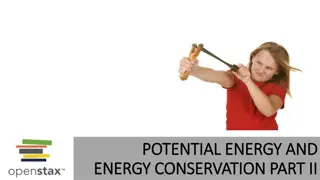Understanding Energy and Its Various Forms
Discover the concept of energy and its different forms, including potential and kinetic energy. Learn about elastic and gravitational potential energy, as well as common types such as mechanical, thermal, and chemical energy. Engage in interactive activities to distinguish between potential and kinetic energy and explore real-world examples. Gain insights into the fundamental ability of energy to do work and bring about change in our surroundings.
Download Presentation

Please find below an Image/Link to download the presentation.
The content on the website is provided AS IS for your information and personal use only. It may not be sold, licensed, or shared on other websites without obtaining consent from the author. Download presentation by click this link. If you encounter any issues during the download, it is possible that the publisher has removed the file from their server.
E N D
Presentation Transcript
ENERGY Textbook pp. 140-153
Do NOW On p 2, name 3 things you used this morning that have or use energy.
ENERGY is the ability to do WORK or cause change Name 2 things that ARE energy or that HAVE energy WORK is when a FORCE moves an object a FORCEis a push or a pull
There are two main kinds of energy POTENTIAL ENERGY KINETIC ENERGY STORED energy or Energy that is NOT being used Energy that IS being used or Energy in MOTION Examples: Examples:
Demonstrate POTENTIAL ENERGY using the ball on your table AND draw a picture showing what potential energy looks like. Now, use the same ball to demonstrate KINETIC ENERGY. Again, draw a picture to show what kinetic energy looks like.
Write a P or a K under each picture on your paper to tell whether the pictures are showing POTENTIAL or KINETIC energy. zzzz K P K K P
Elastic Potential Energy Elastic potential energy is associated with objects that can be stretched or compressed. Elastic potential energy can be stored in rubber bands, bungee chords, trampolines, springs, an arrow drawn into a bow, etc.
Gravitational Potential Energy Gravitational Energy is the energy of position or place. A rock resting at the top of a hill contains gravitational potential energy. Hydropower, such as water in a reservoir behind a dam, is an example of gravitational potential energy.
Do Now: Click in A for Potential energy and B for kinetic energy: 1. 2. 3. 5. 4. 6.
6 DIFFERENT FORMS OF ENERGY Both potential & kinetic energy come in many forms. Six of the most common ones are: MECHANICAL ENERGY Energy of moving parts THERMAL (HEAT) ENERGY Energy of the heat IN an object CHEMICAL ENERGY Energy in chemical bonds of food, gas, batteries, burning wood etc.
6 DIFFERENT FORMS OF ENERGY (continued) ELECTRICAL ENERGY Moving electrical charges ELECTROMAGNETIC ENERGY Light energy, X-rays, radio waves NUCLEAR ENERGY Stored in the nucleus of an atom & released when atoms are split or joined together, nuclear reactors, atomic bombs, stars, sun
Do Now: Use the e-clicker to click in the form of energy the object has. a. electrical energy b. chemical energy c. mechanical energy d. nuclear energy e. electromagnetic energy f. heat energy. 1. 2. 4. 3. (Nuclear power plant )
Energy Transformations Conversions Between Forms of Energy A change from one form of energy to another is called energy conversion. Most forms of energy can be converted into any other form. For example a toaster converts electrical energy to thermal energy. Your body converts chemical energy in the food you eat into the mechanical energy you need to move your muscles. Usually heat energy is also formed in an energy conversion. Electrical Energy into Thermal Energy Chemical Energy into Mechanical Energy
ENERGY CONVERSIONS (ENERGY TRANSFORMATIONS) Energy can be converted (transformed or changed) from one form to another. For example 1) Food has POTENTIAL CHEMICAL energy. 2) When you eat it, the bonds in the atoms are broken and the energy is released to your cells. 3) Your body CHANGES the chemical energy to KINETIC MECHANICAL ENERGY when you run, jump, write, walk. 4) Finally, your body creates THERMAL (HEAT) ENERGY you can feel because the molecules inside you are moving!
Think about the energy conversions taking place with a flashlight. Use the flow chart in your notes to show each form of energy that occurs. Light & Heat Batteries Wires CHEMICAL ENERGY ELECTRICAL ENERGY ELECTROMAGNETIC ENERGY
Label the ENERGY CONVERSIONS in your notes. ELECTRIC PENCIL SHARPENER WIRES GEARS & BLADES mechanical energy electrical energy
HEATING PAD HEAT WIRES electrical energy thermal energy
PLANT PHOTOSYNTHESIS SUN Plant changes sunlight and water into sugar (food) for plant! electromagnetic energy chemical energy
Law of Conservation of Energy When one form of energy is converted to another, no energy is destroyed in the process. Energy cannot be created or destroyed, so the total amount of energy is the same before and after any process. All energy is accounted for. Conserving Energy When you hear or read about conserving energy, don t get confused with the law of conservation of energy. Conserving energy means saving energy, or not wasting it! In Science, energy is always conserved because its total quantity does not change. http://tonto.eia.doe.gov/kids/energy.cfm?p age=about_home-basics
DO NOW With your elbow buddy: Take the index card from the bin. Keeping the fold up, use two hands to pull the ends out to flatten out the card. Predict what will happen to the card as you let go. Test and then explain your prediction. Use the terms potential and kinetic energy.
Energy Conversion in a Pendulum A continuous conversion between kinetic and potential energy takes place in a pendulum. At the highest point in its swing, the pendulum has only potential energy. As it starts to swing downward, it speeds up and its potential energy changes to kinetic energy Potential Energy 5 1 2 4 3
Energy Conversion in a Waterfall The water at the top of the falls has gravitational potential energy because it is higher than at the bottom. As the water falls, its height decreases, and loses its potential energy. At the same time, its kinetic energy increases because its velocity (speed) increases. The potential energy is converted into kinetic energy. Gravitational Potential Energy Kinetic Energy QuickTime and a TIFF (Uncompressed) decompressor are needed to see this picture.
Review: There are two TYPES of energy: potential and kinetic. Energy can t be created or destroyed so we need to convert energy we have into what we need. The energy we use comes from many sources: Fossil fuel (coal, oil, natural gas), nuclear power, sun, wind, geothermal, hydropower. Most of this we convert into electricity (electrical energy). There are 6 forms of energy: mechanical, chemical, nuclear, electromagnetic, thermal, electrical . Energy can change from one form into another but is not created or destroyed.
Do Now: How many people does it take to turn on a light bulb? Where do we get our energy from? How is electricity made ?
Do Now: On p. 13, describe what is happening in each panel of my cartoon.
electricity school house rock Where do we get electricity? Energy conversions from fossil fuel: real life power plant http://www.youtube.com/watch?v=20Vb6hlLQSg







